Side Return Extension Cost
Last updated 24th July, 2024
Have you been looking into a side extension?
If you've got big side extension ideas, this cost guide contains all the information you need for pricing up those details. Whether it's likely to be a narrow side return extension or something more expansive, we've got it covered, from supply costs, labour fees, and anything else that might affect the final outlay.
On average, you can expect to pay upwards of £20,000 for a fully constructed side return.
Let's get started!
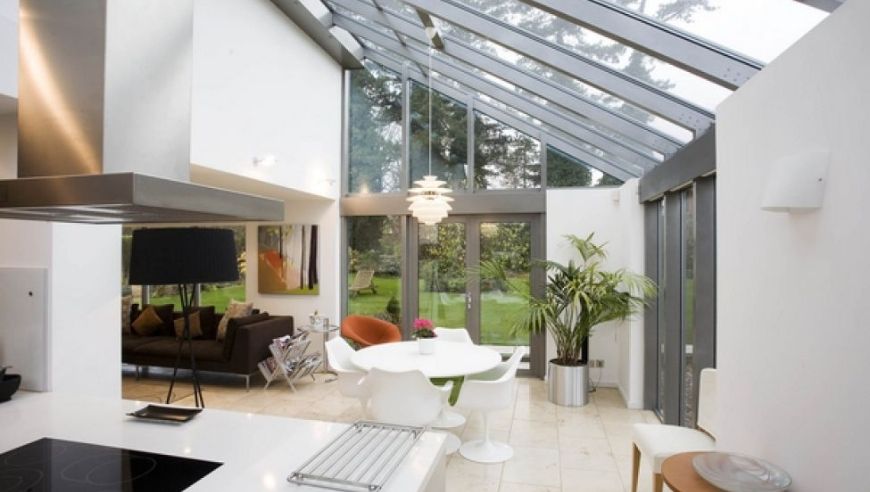
How Much Does a Side Return Extension Cost?
Side return extension cost varies depending on several factors. For example, a small side return extension will cost considerably less than a two-storey side extension fitted out to a high specification.
The average single storey side extension cost per square metre will be £1,200-£1,400 for a basic fit-out. For a slightly higher quality build, you can expect to pay between £1,500-£1,800 per square metre while a high specification will cost £1,700-£2,100 per square metre on average.
A two-storey side extension will be more expensive, but the price difference will not be much more than a single storey side extension. This is because both types of side extension will require foundations and a roof which are some of the more expensive aspects of any build. A two-storey side extension will therefore only require additional walls and a suspended timber floor.
The cost per square metre for a basic two-storey side extension will be between £1,300-£1,600 per square metre. The price per square metre for a mid-range double-storey side extension will be approximately £1,700-£2,100. For a top-end finish, a two-storey side extension cost will be around £1,800-£2,500 per square metre.
Of course, there are many things that the cost of side extensions will depend on such as size, type of property, area of the UK that you live in and the quality of the finish. Other contributing factors such as ease of access to the site, the type of soil that the house is built on, and the type of waste generated by the build will all add to the overall cost.
Table of Contents
- How much does a side extension cost?
- Labour costs and time frames
- What does building a side extension entail?
- Cost affecting factors of building a side extension
- Building regulations for side extensions
- Planning permission for side extensions
- DIY side extension
- FAQs
- How to find & hire a side extension specialist
- Sources
Side Extension Prices
Below are the average costs for building a single storey side extension and a two-storey side extension of various sizes. The prices include labour and materials.
| Single Story | 20 sqm | 25 sqm | 35 sqm |
|---|---|---|---|
| Basic | £25,000-£30,000 | £30,000-£37,500 | £40,000-£50,000 |
| Mid Range | £30,000-£35,000 | £35,000-£45,000 | £50,000-£60,000 |
| High Quality | £35,000-£42,000 | £42,500-£52,500 | £60,000-£72,500 |
| Two Storey | 40 sqm | 60 sqm | 80 sqm |
|---|---|---|---|
| Basic | £50,000-£65,000 | £80,000-£95,000 | £105,000-£130,000 |
| Mid Range | £70,000-£80,000 | £100,000-£120,000 | £135,000-£160,000 |
| High Quality | £72,000-£100,000 | £110,000-£150,000 | £145,000-£200,000 |
Supply Costs
The below table sets out the supply only costs for different sizes and finish of single-storey side extensions and double-storey side extensions. The costs do not include labour or installation of any parts of the extension and reflect the price of materials only.
| Single Storey | 20 sqm | 25 sqm | 35 sqm |
|---|---|---|---|
| Basic | £10,000-£12,000 | £12,000-£15,000 | £16,000-£20,000 |
| Mid Range | £12,000-£14,000 | £14,000-£18,000 | £20,000-£24,000 |
| High Quality | £14,000-£17,000 | £17,000-£21,000 | £24,000-£29,000 |
| Two Storey | 40 sqm | 60 sqm | 80 sqm |
|---|---|---|---|
| Basic | £20,000-£26,000 | £32,000-£38,000 | £42,000-£52,000 |
| Mid Range | £28,000-£32,000 | £40,000-£48,000 | £54,000-£64,000 |
| High Quality | £29,000-£40,000 | £45,000-£60,000 | £58,000-£80,000 |
Additional Costs
Side extension prices will not solely be for the materials and labour required to construct it. There will be additional costs associated with the build.
There are a few different ways to approach the project; you could hire a main contractor who deals with everything on your behalf or hire a main contractor as well as some sub-contractors.
You could also sub-contract each trade or do as much of the labour on a DIY basis as practicable and hire trades for those you cannot do yourself.
Whichever build route that you take there will be costs associated with each.
Fees for Services
If you employ an architect's services, the fees for this will be around 3%-7% of the construction costs. For a project manager, the cost will be similar at between 4%-7% of build costs. For those projects which will require planning permission the fee for this is £206 currently.
The fee for a structural engineer will be between £500-£1,000 while building control charges may be around £800-£1,000.
If the party wall between your property and a neighbouring one is affected by the side extension, you will need to issue a Party Wall Notice to notify them of the works. If there is an objection, then a Party Wall Agreement will be necessary, which will cost between £700-1,000.
You bear this cost as the person carrying out the works regardless of who appoints the surveyor, you, or your neighbour.
Fit Out
Naturally, once the side extension is built, then there will be the cost of the internal fit-out. These costs will be dependent on the side extension ideas that you have for the new living space.
Installing a Kitchen
A new kitchen or kitchen/diner is a very popular option for a side return extension; however, this is also one of the more expensive additions to a property.
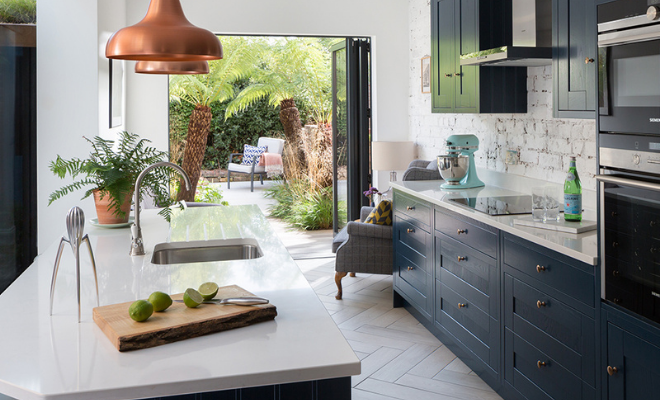
The installation of kitchen cupboards, worktops, appliances, and glazing will all add to the overall budget.
To fit a new kitchen suite you can expect to pay between £5,000-£20,000 depending on the quality of the installation, types of appliances fitted and overall size of the kitchen.
Fitting a Roof Lantern
A nice addition to the list of side extension ideas is the fitting of a roof lantern on the flat roof of your kitchen or kitchen/diner. It will give a lot of natural light and add to the overall feeling of space in the room. The cost to install a roof lantern will be between £2,000-£3,000 depending on its size and where in the country you live.
Bi-fold Doors
Bi-fold doors are another item that can be added to the great side extension ideas list. They allow a huge amount of light into the property and can bring a sense of outside space into the home when opened.
Installing bi-fold doors will cost on average £2,000-£4,000 depending on size, material, and specification.
Adding a Bathroom
After kitchens, bathrooms are the most popular addition when extending a home. They are also one of the more expensive rooms to add to a property as there is the need for new sanitary ware as well as the labour of a qualified plumber. Installing a new bathroom suite will cost approximately £3,000-£4,000, but this can vary according to the bathroom's size and the quality of the fitted suite.
New Windows
While a single storey side extension may only have patio or bi-fold doors as glazing, a two-storey side extension will require additional windows. The choice of frame material, as well as the size of the window, will have an impact on the cost. Deciding whether to have double or triple glazing will also impact the price.
Installing double glazed windows will cost an average of £250-£600 per window for casements depending on whether the frames are uPVC, timber, or aluminium and according to their size. Double glazed sash windows will cost more at around £750-£1,000 each but again this will depend on frame material and size.
Triple glazed windows can range in price from £500-£1,500 each for casement windows depending on size and frame material. Sash triple glazed windows can cost between £750-£2,500 according to the frame material and size of the windows.
The cost to install triple glazing windows in a two-storey side extension will depend on the number of windows required, the material that the frames are made from and the size.
Decorating
Once the side extension is built and internally plastered the rooms will need to be decorated. Some people will do this themselves as a DIY project to save money, but some prefer to hire a professional decorator.
Painting an internal room will involve the walls and ceilings but also the woodwork such as skirting boards and window sills. The cost per room will be approximately £400, although this will obviously depend on the size of the room.
Installing Additional Heating
For a side return extension which will usually consist of a kitchen or kitchen/diner, the installation of underfloor heating is a practical solution for additional heating. Most underfloor heating is installed during construction although it is possible to retro-fit with some types.
The cost to fit underfloor heating will be in the region of £60-£75 per square metre depending on the type fitted.
The cost to install additional radiators in a two-storey side extension will depend on the number of radiators needed. The average cost to fit traditional radiators will be around £200-£300 each although some designer or more modern radiators may cost a lot more.
Cost Breakdown Calculator
Individual costs to build a mid-range two-storey side extension - Total Cost: £75,000
Materials
£30,000
Tradesmen
£41,250
Waste Removal
£3,750
Labour Costs and Time Frames
The labour costs and timeframes will vary depending on whether you are building a single storey side extension or a two-storey side extension. While both will need foundations and a roof, a two-storey extension will need floor joists, and there will be extra internal walls.
Labour
Typically, the side extension prices will consist of labour costs at around 60% of the construction cost for either a single storey or two-storey side extension. If you have hired a main contractor to carry out the work in its entirety, then the labour costs will be included in the quotation.
They will supply all the necessary trades for completion of the project, including block layers, labourers, roofers, plasterers, electricians, plumbers, and carpenters.
For those who hire a contractor to build the extension to a weathertight stage and hire sub-contractors to carry out the internal fit-out, then prices will need to be agreed with these sub-contractors separately.
You may pay a main contractor to get your side extension weathertight and then do as much of the finishing off yourself as you can without employing additional labour.
However, unless you are a qualified electrician, you will need to hire one to do the first and second fix electrics.
If you engage the services of an architect, the fees will need to be added to your labour costs, and this can be 3%-7% of the build cost. You will also need a structural engineer, and you can expect to pay between £500-£1,000 for their services.
Timeframes
Even a small side return extension will be built in several stages, and each stage will have a distinct timeframe.
Planning Permission
Most extensions will not require planning permission, and chances are you will be building a permitted development side extension. Still, you should check with your local authority before proceeding with any building work.
Foundations
Once architectural plans and structural calculations are in place and conform to Building Regulations, the foundations for the single or two-storey side extension can be dug. The depth of the foundations will need to be checked by a building control inspector.
Once they are approved, the concrete can be poured and left to harden. This process should take no more than a couple of days, although the temperature can affect the time it takes for the concrete to go off.
Walls
Following the installation of the foundations, the walls of the side extension can be built. Depending on the size of the project, this may take several days.
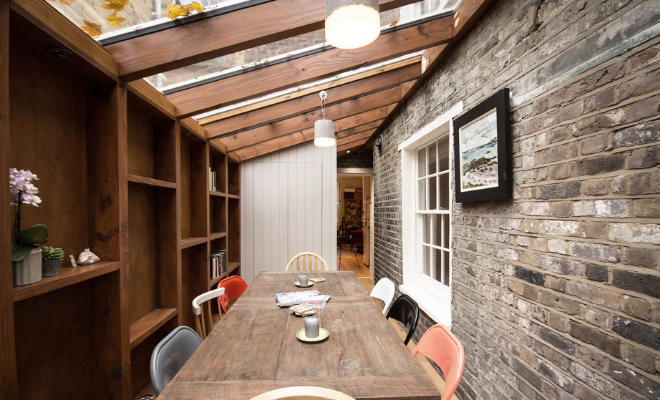
For a single or two-storey side extension the walls will normally consist of a double skin of blocks or bricks with a cavity between the two which is filled with an appropriate insulation material.
Floor
The floor of a single storey side extension will be built when the walls have been completed and will consist of a layer of hardcore covered with a layer of concrete which is commonly called oversite.
Laying this floor will take 2-4 days depending on the size of the side extension. The second storey suspended timber floor will similarly take 2-4 days to complete for a two-storey side extension.
Steel Beams
For a two-storey side extension, a steel beam may be needed to support the new floor and the weight of furniture on the first floor. The installation should take no more than a couple of hours.
Roof
The timeframe to build the roof will be more or less the same for a single or double-storey side extension. Normally the roof will be complete within a couple of weeks. For a small side return extension with a flat roof, this may be even less although if you are installing a roof lantern, this could add to the timeframe.
First Fix
Depending on the side extension's size, the first fix electrics and plumbing can take one to two weeks. Once this is complete the drylining and plastering can be done which may take another week or two.
Doors & Windows
Fitting doors and windows will take around 2-3 days, although this will depend on the size, style and number of windows and doors.
Internal Fitout
Potentially the longest part of the build process of an extension of any size is the internal fit-out. Of course, the use to which the extension is being put will determine exactly how long that will take, but typically this stage can take 4-8 weeks. Second fix electrics, plumbing, carpentry, floor coverings, tiling and decorating are all normally included in this stage.
What Can Affect Labour Costs and Timeframes
There are several factors which may affect the labour costs and timeframes of a side extension. The soil type of the area may make the digging of foundations more time-consuming.
Clay or chalky soil may require deeper foundations or a different type of foundation than you were planning. Foundations dug into rocky ground may require heavier machinery than normal, which can add to the timeframe and labour costs.
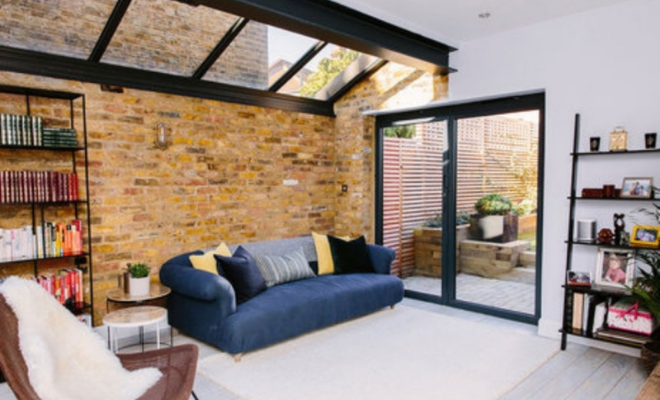
Tree roots may be reaching into the area of the foundations, and their presence could also mean that deeper foundations will be required. Similarly, proximity to a sewer pipe or other drainage may involve an adjustment to the foundations.
Timeframes can be affected by adverse weather conditions such as high winds, heavy rain or freezing temperatures. As a consequence, the labour costs may also be impacted.
If you have a problem with the delivery of materials, then this may slow the progress of your side extension build. Lost time on site waiting for materials will also affect the labour costs if trades are unable to proceed with work.
What Does Building a Side Extension Entail?
There are many stages to consider when building a side extension, whether it is a single storey or a two-storey side extension.
Preparation
- Potentially the most important part of the whole process is the preparation. This will involve having obtained at least three quotations for work and speaking to each of the potential contractors about the whole process.
- It is also advisable to have an architect draw up plans and have structural calculations done. The project will progress much better if the builder has proper plans to work from and correct structural calculations are vital to ensure safety and compliance with building regulations.
- Most builds of this nature will be permitted development side extensions, but you should check with your local authority's planning department before you begin. You will also need to submit a notice of works to them before you proceed.
Groundworks
- Groundworks for a single or double-storey side extension will involve clearing the site, digging the foundations, and pouring the concrete footings. For both single and double-storey side extensions, the foundations' size should be 600mm wide and at least a metre deep.
- Prior to the concrete being poured, the building control inspector will need to check that the foundations are adequate and correct.
- Concrete can be poured straight from a specialist concrete mixing lorry, or it can be done manually with a concrete mixer on site.
- Some soil types may require different kinds of foundations so it will be necessary to know what the soil type is that you are building on.
- Foundations are a critical stage in the building of side extension as getting them wrong could have dire consequences for the property and the people living in and around it.
Walls
- The walls are built up from the concrete footings and are a double skin of either blocks or a combination of blocks and bricks. The resulting cavity is filled with insulation which needs to comply with Building Regulations.
- Guide strings are put in place to create a straight line for the blockwork with the corners being set first to make sure that the extension will be square.
- The first line of blocks will be set in 10-12mm of mortar. Subsequent layers of blocks are staggered so that the joints do not line up and create a point of weakness in the wall.
- A damp proof course should be fitted within the walls at 150mm above ground level. This is to prevent moisture rising from the ground into the walls. A damp proof course is also mandatory under Building Regulations.
- Lintels made from steel beams or reinforced concrete are inserted above apertures for windows or doors in the side extension.
Roof
- Single storey side extension roofs can be flat or pitched, but two-storey side extensions will typically be pitched.
- Roof joists are built off the walls of the extension and any structural support steel beams installed.
- For flat roof timber firrings which are tapered lengths of wood are fitted perpendicular to the roof joists. Structural OSB board is laid on top along with a two to three layers of felt. The tapered firrings allow water to run off the roof.
- Double-storey extensions will typically have a pitched roof consisting of a ridge beam and rafters. This is then covered with a breathable membrane and tiled or slated to match the existing part of the roof.
- The inclusion of a roof lantern in a flat-roofed side extension can bring a lot of light into what might otherwise be a dark room of the house, particularly a mid-terrace extension.
Floor
- The floor base will be hardcore, and this is packed into place with a whacker or vibration plate.
- The layer of hardcore is then covered with a layer of sand which is also compacted. The sand protects the damp proof course from being ripped by sharp edges on the hardcore.
- A damp proof course is then laid on top of the sand and overlapped with the DPC from the external walls. This is to comply with Approved Document C of Building Regulations.
- The concrete is then poured, and this will take a couple of days or more to harden depending on the weather.
- When the concrete of the floor has dried, appropriate insulation can be laid. This could be boards of polyisocyanurate (PIR) or blanket insulation.
- A supporting timber framework is then placed on top of this insulation, and a layer of flooring chipboard fixed to it.
Doors & Windows
- A single-storey side extension will most likely have either French doors or bi-fold doors and a window or two depending on the extension's size and layout. Two storey side extensions will have windows on the first floor as well as on the ground floor.
- Window and door measurements should be checked against plans and apertures prior to ordering. All window and door apertures should have a damp proof course in place.
- Frames for windows and doors are fitted first and checked to ensure that they are level, plumb and square.
- Once the frames are in place, the glass for the windows and doors can be installed followed by the beading. The frames are then sealed internally and externally with a silicone sealant.
First Fix
- The first fix plumbing and electrics can be done once the side extension is weathertight. First fix involves running cables and pipework to where they are needed within the extension, and this is usually done before the dry lining and plastering.
- The electrician will make a plan for the position of the lights in the ceiling and run wiring to those positions. After the plasterboard is installed, he will be able to cut through to access the cabling and install the lights.
- Similarly, the wiring for switches and sockets will be run to where they are needed during the first fix electrics.
- First, fix plumbing involves installing pipework for sanitary ware in bathrooms and for water supply in kitchens.
Drylining and Plastering
- Following the first fix electrics and plumbing, the plasterboard will be installed in the internal walls and ceilings.
- Skimming of walls and ceilings can be done when all the plasterboard is in place. This involves a thin coat of plaster that goes over the plasterboard to create a smooth and even finish.
- Joints between the plasterboards are covered with scrim tape which stops the finishing plastering sinking into the joins and cracking when dry.
Second Fix
- Second fix electrics involves fitting all lights, sockets, and switches or other fitted electrical appliances.
- If a bathroom is part of the side extension, the second fix plumbing will involve fitting sanitary ware such as a toilet, sink, bath, or shower. For a kitchen, it would mean installing a sink and possibly appliances such as a dishwasher or washing machine.
- Second fix carpentry is the fitting of skirting, architraves, laying floors and hanging doors.
Decorating
- Some people will decorate their new side extensions to save money, and some will prefer to hire a professional decorator.
- Decorating a side extension will involve painting walls, ceilings, and woodwork. It may also involve hanging wallpaper or tiling.
Does the Method Change?
Building a single storey side extension will be different from building a two-storey side extension in terms of the amount of work and materials involved. There may be other differences too.
A single-storey side extension usually does not require scaffolding, and most work can be done from ground level or work platforms. Double-storey extensions will definitely need scaffolding.
Typically, a single storey side extension will have a flat roof while a double-storey side extension will have a pitched roof. Although some single-storey side extensions such as side returns may have a mono-pitch roof.
Permitted development side extensions are reserved for single storey additions, or if you have a detached house, then you can add a two-storey extension. However, this only applies to houses built after 1948, so many houses will require planning permission for a double-storey extension.
Cost Affecting Factors of Building a Side Extension
Several factors will affect the cost of building a single storey side extension or a two-storey side extension.
Type of Extension
Although a two-storey side extension may be twice as large, the actual cost per square metre will not be double that of a single storey side extension. This is because both single and two-storey extensions will require foundations and a roof which are among the more expensive components of an extension project.
However, the additional labour and timeframe for completing the work will inevitably push the costs up and add to the overall price. The need for a suspended timber floor and extra internal walls plus the cost to fit out the additional rooms will mean that a two-storey side extension will be more expensive to build than a single storey side extension.
A glass side return extension is typically more expensive than its brick equivalent, simply because of the added complexity of the build.
Soil Type
The type of soil that your property sits on will have an impact on the kind of foundations that your single-storey or double-storey side extension will need. Soil type is an important part of the building process as the weight of the foundations, and the resulting extension will be supported by the underlying ground.
Different soils have different load-bearing capacities, so this will affect the type of foundations that need to be in place. How the soil reacts to different moisture content levels will also have an effect on the cost of digging the foundations.
To reduce the amount of ground movement due to moisture levels, the foundations may need to be deeper, and this will have a cost implication both in terms of labour and timeframes.
Extension Use
The intended purpose of the side extension will directly affect the cost of its design, build, and fit-out. A kitchen or kitchen/diner side extension is probably one of the most expensive to build as it will need new worktops, storage units and appliances.
Of course, there are various finishes in all of these elements, and there are budget, mid-range, and high-end options so the choice will directly affect the price you pay. Even if the new room in your side extension is purely living space, then the quality and style of the furniture and décor will impact the cost.
Type of Property
The kind of house you are extending will affect the cost of your side extension project. Most people will be allowed a permitted development side extension and as such, will not have to apply for planning permission.
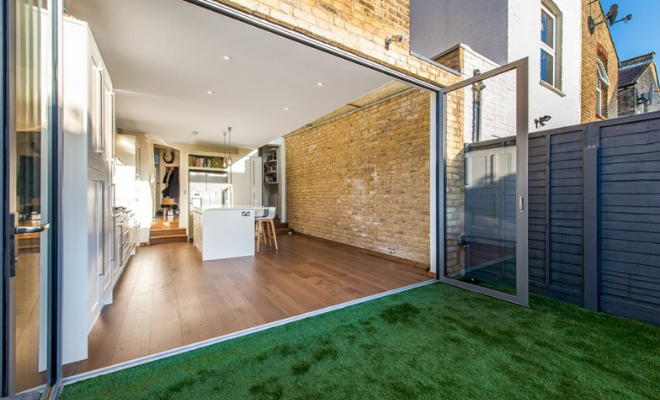
However, if your property is in a conservation area, area of outstanding natural beauty (AONB), in the Broads, a national park or similar, then you will need to apply for planning permission. The cost of applying for planning permission is approximately £200.
Size
The size of your side extension will impact the cost not just for the build price but also the expense of fitting out a single storey or two-storey side extension. Although the building cost gets slightly cheaper per square metre as the size increases due to economies of scale, there will still be increased costs associated with a larger side extension.
On average the price will be around £100-£300 extra per square metre.
Location
Your property's location will affect the price you pay for a single storey or two-storey side extension. Labour and material costs will be more expensive in London and the southeast than in other parts of the country with a difference of around 30% for labour alone.
Finish Quality
The standard of finish for your side extension, both externally and internally will heavily influence the build costs. A high specification for decoration, fittings and furniture will inevitably mean a higher price both for materials and labour.
Some people will spend a lot of money on an extension and then decorate it as a DIY project to save money, but this can have a negative impact on the finished quality of the build. There seems little point in paying for skilled tradespeople to build a high specification extension only to cover it with a bad paint job.
To highlight the craftsmanship of a high-quality build and increase your property's value, it is advisable to hire professionals for all aspects of the project. While it means an extra outlay of perhaps 30-40% more for a top-quality finish, it is an investment in the property and its saleability in the future.
Ease of Access
Access to your site can have cost implications for deliveries of materials, a skip, any required scaffolding, and a mini-digger for excavating the foundations. Narrow roads, sloping sites and restricted parking arrangements can make lorry access tricky and potentially more expensive in terms of time and labour.
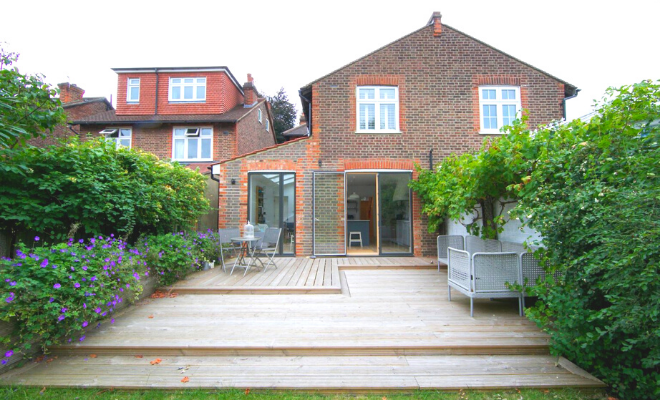
For example, if your property is a mid-terrace with no rear access and you want to build a side return extension, it will be impossible to have a mini-digger on-site for the groundworks. This means that the foundations will need to be dug out by hand, which will significantly increase the cost of labour and the amount of time that it will take for the foundations to be done.
Building Regulations for Side Extensions
The reason for Building Regulations is to ensure standards are met in various elements of the extension. The following need to comply with Building Regulations within an extension:
- Doors and windows
- Drainage
- Electrics
- External walls
- Kitchen & bathroom
- Internal walls
- Roof
This compliance guarantees that the build will be structurally safe conserve energy and not pose a risk to occupants or others.
Building Regulation Applications
There are a couple of ways that you can apply for Building Regulation approval. The first is to submit full plans to the local authority, including all structural calculations. The building control department can determine if the extension will meet all necessary Building Regulations from the plans.
You will either get full approval or conditional approval which would require some modification to the plans.
A Building Notice will give the local authority a description of the works to be carried out and provide the property's address. This allows the local council to carry out inspections at various stages of the project. Work on the side extension can begin within 48 hours of the Building Notice being submitted.
The works' final inspection will be done when the build is finished, and a completion certificate will be issued.
This is a very important document and should be kept safe as it confirms that the side extension complies with Building Regulations. It will also be needed if you should ever want to sell your house.
Another important document, a Part P, is required for all electrical work done in the side extension and should be completed and signed by the electrician who carried out the work. This confirms that the work was done in compliance with Building Regulations by a qualified electrician and will also be required when selling your home.
Cost of Building Regulation Approval
Local authorities will differ in how much they charge for inspections and approval, but you can look on their website or contact the building control department and ask for a list of their fees. Normally the cost for approval via the full plans route will split the fee between assessing the design phase and the inspection phase.
The cost of a Building Notice should be similar but could be slightly more expensive. It is also possible to use an independent building control inspector, but again you would need to contact them and ask how much their fees would be.
Planning Permission for Side Extensions
The majority of single-storey side extensions can be done under permitted development rights, and in these cases, there will be no need to apply for planning permission.
There are some exceptions, however:
- Properties in conservation areas, areas of outstanding natural beauty (AONB), national parks, world heritage sites, the Broads, or any area that the Secretary of State specifies for protection.
- If the planned extension exceeds the size that is allowed under permitted development.
- You wish to use materials that do not match the existing property.
- If you want to install a balcony, veranda, or other raised platform, chimney, flue, soil or vent pipe, satellite dish or tv aerial.
Two storey side extensions can only be done under permitted development rights on detached houses. All other properties where a two-storey side extension is desired will need to have planning permission.
The cost to apply for planning permission in the UK is approximately £200 with regional variations between England, Wales, and Scotland.
Information on planning application fees can usually be found on your local authority's website, or you could contact their offices for a list of fees.
DIY Side Extension
Unless you are a competent builder completing a job as large as a side extension will be beyond most DIY enthusiasts' capability. Even an accomplished builder cannot do everything unless they are also a qualified electrician, plumber, plasterer, and carpenter.
So, for the vast majority of people, the job of building a side extension is best left to professional contractors.
Dangers of DIY
Apart from the range of skills that would be needed to complete a side extension as a DIY project, there are inherent dangers in construction on this scale. The risk of injury on a construction site should not be taken lightly, and for this reason, letting professional contractors do the work is advisable.
Some of the dangers of DIY work are falls from height, crush injuries, cuts from tools and accidental or unintentional contact with electricity. There is also the risk that as a nonprofessional, you may inadvertently breach Building Regulations and have to re-do or undo some of the work.
What Can be Done with DIY?
Of course, there are aspects of a side extension that can be done as a DIY project. Decorating such as painting, wallpapering, and even tiling are popularly done as a DIY task to save money or to put a personal stamp on the new living space.
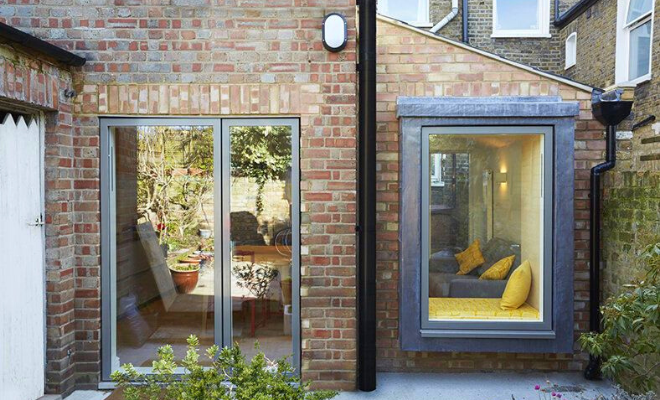
The amount of money that you save will depend on the parts of the side extension that you can do yourself. If you are confident about painting, wallpapering, or tiling you could save yourself between £120-£160 per day. You could also lay your own floor covering, saving around £150-£200 per day.
Tools & Equipment
Depending on which parts of the project you decide to do yourself, you will need particular tools & equipment. For painting, you will need:
- Dust sheets
- Masking tape
- A roller and tray or a paint sprayer
If you are using a paint sprayer, you should wear protective goggles.
To lay flooring the tools you need will depend on the type of flooring being laid but for a lot of wooden flooring you will need:
- A pencil
- Measuring tape
- Spirit level
- Hand or electric saw
- Pull bar
You may also want to wear knee pads to protect your knees.
Building Regulations will need to be followed, and at various stages of the build, a building control inspector will need to check that the work is being done to Building Regulation standards.
FAQs
This is normally done on end of terrace or semi-detached properties but can also be done on mid-terraced homes where an existing extension does not take up the rear garden's full width.
Although the two-storey side extension offers more space and will take longer to build the price per square metre is not hugely dissimilar to a single storey side extension.
This is due to economies of scale but also because both single and two-storey extensions will need foundations and a roof, which can be the more expensive parts of a build. The average cost of a mid-range 60sqm double-storey extension is between £100,000-£120,000.
Other criteria for planning permission are when the extension exceeds the allowances for permitted development, the materials used for the extension do not match existing or where additions such as a chimney or flue are proposed.
Two storey side extensions will need planning permission unless built on a detached house.
Initially, a party wall notice is sent to adjoining neighbours explaining what work is proposed. If the neighbour agrees, the work can go ahead.
However, if they dispute the work, then a party wall surveyor will need to be hired, and a Party Wall Agreement put in place.
The cost of a surveyor is always the responsibility of the homeowner carrying out the works.
How to Find & Hire a Side Extension Specialist
Building a side extension is a large undertaking and will require the skills of several trades. For this reason, the build route that you take is important in terms of cost, time, and the quality of the finished build.
You could hire a main contractor who will manage all aspects of the build, including material deliveries, labour, scaffolding if needed and waste disposal. This build route means that the homeowner has little hands-on involvement. Alternatively, you could manage the project yourself and hire subcontractors.
The best way to find a good extension specialist is through a recommendation from friends and family. The obvious advantages are that you know the builder's previous clients and trust their word and you can see the work for yourself and gauge if it is what you are looking for in your side extension.
Cost
The average cost to hire a side extension specialist will depend on where in the country you are located, the size of the extension and the quality of the finish.
The price per square metre is typically between £1,200-£2,100 for a single storey side extension depending on whether it is a basic, mid-range or high spec finish. For two-storey side extensions, the cost per square metre is between £1,300-£2,500 ranging from basic to top quality finish.
What to Look For
When searching for a side extension specialist, it is advisable to look for someone who has a good reputation locally. They should be able to offer viewings of previous side extensions as an example of their work and preferably have been in operation for at least five years.
Having business premises and liveried vehicles is also a good sign that the contractor is established and reliable.
Qualifications
Most contractors will have done an apprenticeship and then gone on to learn their trade on site under more experienced builders. This is the most common route for building contractors although as part of their apprenticeship they will have probably undertaken some academic study in the form of an NVQ or City & Guilds.
Experience
The more experience your building contractor has in side extensions, the more confidence you can have that he will deliver the build that you want. This is why it is important to hire someone who is well established in your area and who can show examples of previous similar work.
Accreditation
There are several accreditation schemes that building contractors can sign up to. For example, the Federation of Master Builders (FMB) is a trade association who promote quality construction and endorse good contractors. TrustMark is an accreditation scheme which is a government-endorsed and supports consumer protection and quality service within construction.
Insurance
All tradespeople working in your property must have insurance, and the most likely type will be public liability insurance. As a potential client, you are within your rights to ask about this and to get proof of the contractor's insurance.
Most reputable builders will anticipate this and be willing to provide it. If you are having difficulty getting proof of insurance from a contractor, then you should be wary of engaging their services.
Checking Certifications and Qualifications
It is usually possible to check the accredited status of a building contractor on the scheme's website with which they are associated. Many tradespeople will provide copies of their membership certificates with their written quotations.
Sources
https://www.simplyextend.co.uk/how-much-will-a-side-return-extension-cost-in-london/
https://www.houseup.co.uk/news/double-storey-extension-guide/
https://www.homebuilding.co.uk/advice/foundation-systems-and-soil-types
https://www.planningportal.co.uk/info/200130/common_projects/17/extensions/5
https://www.homesandproperty.co.uk/property-news/home-extensions-new-rules-permitted-development-government-a139556.html
https://www.homebuilding.co.uk/ideas/side-return-extension-design-guide
https://www.fastplansuk.co.uk/how-much-does-a-side-return-extension-cost










